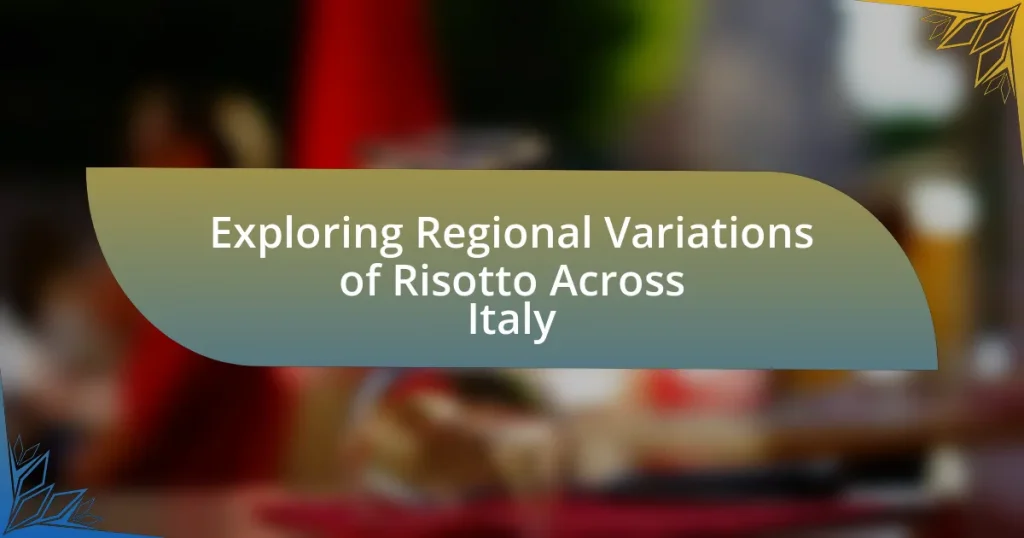The article explores the regional variations of risotto across Italy, highlighting how local ingredients and culinary traditions shape this iconic dish. It details specific risottos such as Risotto alla Milanese from Lombardy, Risotto al Nero di Seppia from Veneto, and Risotto al Barolo from Piedmont, each showcasing unique flavors and preparation methods. The article also examines the key ingredients used in Northern and Southern Italian risottos, the historical factors contributing to risotto’s popularity, and essential cooking techniques for achieving the perfect creamy texture. Additionally, it provides insights into selecting the best local ingredients and common mistakes to avoid when preparing risotto at home.

What are the regional variations of risotto across Italy?
Risotto varies significantly across Italy, with each region showcasing unique ingredients and preparation methods. In Lombardy, the famous Risotto alla Milanese features saffron, giving it a distinctive yellow color. In Veneto, Risotto al Nero di Seppia incorporates cuttlefish ink, resulting in a striking black dish. The Piedmont region is known for Risotto al Barolo, which uses the local red wine for depth of flavor. In Emilia-Romagna, Risotto con Asparagi highlights fresh asparagus, while in Campania, Risotto alla Pescatora combines seafood for a coastal twist. These variations reflect local agricultural products and culinary traditions, illustrating Italy’s rich gastronomic diversity.
How do different regions influence the ingredients used in risotto?
Different regions of Italy significantly influence the ingredients used in risotto, reflecting local agricultural products and culinary traditions. For instance, in Lombardy, risotto alla Milanese features saffron, a spice that thrives in the region’s climate, while in Veneto, risotto al nero di seppia incorporates cuttlefish ink, showcasing the coastal area’s seafood availability. Additionally, regions like Piedmont utilize local mushrooms and truffles, emphasizing the area’s rich forest resources. These regional variations not only highlight the diversity of Italian cuisine but also demonstrate how geography and local produce shape traditional dishes.
What are the key ingredients specific to Northern Italian risottos?
The key ingredients specific to Northern Italian risottos include Arborio rice, broth (often made from meat or vegetables), butter, onions, and Parmesan cheese. Arborio rice is essential due to its high starch content, which creates the creamy texture characteristic of risotto. The use of broth enhances the flavor, while butter and onions contribute to the richness and depth of the dish. Parmesan cheese is typically added at the end for a savory finish, reinforcing the traditional flavor profile of Northern Italian cuisine.
How do Southern Italian risottos differ in their ingredient choices?
Southern Italian risottos differ in their ingredient choices by incorporating local seafood, vegetables, and regional cheeses. For instance, risottos from coastal areas often feature fresh fish, shellfish, and ingredients like tomatoes and olives, reflecting the Mediterranean diet. In contrast, risottos from inland regions may include ingredients such as wild mushrooms and various types of local cheeses, like ricotta or caciocavallo. This regional diversity highlights the influence of geography and local agriculture on the culinary practices in Southern Italy.
Why is risotto considered a staple in Italian cuisine?
Risotto is considered a staple in Italian cuisine due to its versatility, regional variations, and cultural significance. This dish, primarily made from Arborio rice, absorbs flavors and can be adapted with various ingredients, reflecting local produce and culinary traditions. For instance, in Northern Italy, risotto alla Milanese features saffron, while in Veneto, risotto al nero di seppia incorporates cuttlefish ink. The dish’s historical roots date back to the 15th century, showcasing its long-standing presence in Italian culinary practices. Risotto’s ability to embody regional identities and its role in family gatherings and celebrations further solidify its status as a fundamental component of Italian gastronomy.
What historical factors contributed to the popularity of risotto in Italy?
The popularity of risotto in Italy is primarily attributed to the agricultural practices and climate of the northern regions, particularly Lombardy and Piedmont, where rice cultivation flourished. The introduction of rice to Italy in the 14th century, influenced by trade routes and agricultural innovations, allowed for the development of creamy rice dishes. Additionally, the rise of the aristocracy and their demand for refined cuisine during the Renaissance further popularized risotto as a symbol of culinary sophistication. The dish’s adaptability to local ingredients and flavors also contributed to its widespread acceptance and regional variations, solidifying its status in Italian gastronomy.
How has risotto evolved over time in different regions?
Risotto has evolved significantly across different regions of Italy, adapting to local ingredients and culinary traditions. In Northern Italy, particularly in Lombardy and Piedmont, risotto is often made with Arborio rice and features rich flavors, such as saffron in Risotto alla Milanese or Barolo wine in Risotto al Barolo. In contrast, the Veneto region emphasizes seafood, leading to variations like Risotto al Nero di Seppia, which incorporates cuttlefish ink. Additionally, in the southern regions, such as Campania, risotto may include tomatoes and fresh vegetables, reflecting the Mediterranean diet. Historical influences, such as the introduction of rice cultivation in the 15th century, have also shaped these regional adaptations, making risotto a versatile dish that embodies the diverse culinary landscape of Italy.

What are the most famous types of risotto in Italy?
The most famous types of risotto in Italy include Risotto alla Milanese, Risotto al Nero di Seppia, and Risotto ai Funghi. Risotto alla Milanese, originating from Milan, is characterized by its creamy texture and distinctive yellow color from saffron. Risotto al Nero di Seppia, popular in coastal regions, features cuttlefish ink, giving it a rich, dark flavor. Risotto ai Funghi, commonly found in northern Italy, incorporates various mushrooms, enhancing its earthy taste. These variations reflect Italy’s diverse culinary traditions and regional ingredients.
What distinguishes Risotto alla Milanese from other varieties?
Risotto alla Milanese is distinguished from other varieties primarily by its use of saffron, which imparts a unique golden color and distinct flavor. This dish originates from Milan and is traditionally made with Arborio rice, broth, butter, and Parmesan cheese, but the defining characteristic is the infusion of saffron, which dates back to the 16th century when it was introduced to the region. The combination of saffron and the creamy texture of the risotto creates a signature dish that sets it apart from other regional risottos, which may use different ingredients and flavor profiles.
What ingredients and techniques are unique to Risotto alla Milanese?
Risotto alla Milanese is characterized by its unique use of Arborio rice, saffron, and a specific cooking technique that involves gradual addition of broth. Arborio rice, known for its high starch content, creates a creamy texture essential to the dish. Saffron, which imparts a distinct golden color and rich flavor, is a defining ingredient that sets this risotto apart from others. The technique of slowly adding warm broth while stirring continuously allows the rice to release its starch, resulting in a creamy consistency. This method is crucial for achieving the signature texture of Risotto alla Milanese, distinguishing it from other regional risottos in Italy.
How does the flavor profile of Risotto alla Milanese compare to others?
Risotto alla Milanese has a distinct flavor profile characterized by its creamy texture and the prominent taste of saffron, which imparts a rich, golden hue and a unique aromatic quality. In comparison to other risottos, such as Risotto al Nero di Seppia, which features a briny flavor from cuttlefish ink, or Risotto ai Funghi, which highlights earthy mushroom notes, Risotto alla Milanese stands out due to its luxurious and slightly floral saffron essence. This specific use of saffron is rooted in Milanese tradition, where it has been a staple since the 16th century, showcasing the dish’s historical significance and regional identity.
How does Risotto al Nero di Seppia reflect regional characteristics?
Risotto al Nero di Seppia reflects regional characteristics by showcasing the culinary traditions of the Veneto region, particularly its coastal areas. This dish utilizes cuttlefish ink, a local ingredient that highlights the region’s maritime culture and reliance on seafood. The preparation method, which involves slow-cooking rice with broth and ink, emphasizes the importance of patience and technique in Venetian cuisine. Additionally, the dish’s deep black color and rich flavor profile are emblematic of the region’s unique approach to combining simple ingredients to create complex flavors, a hallmark of Venetian cooking.
What are the key ingredients in Risotto al Nero di Seppia?
The key ingredients in Risotto al Nero di Seppia are Arborio rice, cuttlefish, cuttlefish ink, onion, white wine, fish or seafood stock, and olive oil. Arborio rice is essential for its high starch content, which creates the creamy texture characteristic of risotto. Cuttlefish provides the primary protein and flavor, while cuttlefish ink gives the dish its distinctive black color. Onion adds aromatic depth, and white wine contributes acidity, balancing the richness. Fish or seafood stock enhances the overall seafood flavor, and olive oil is used for sautéing the ingredients.
What cultural significance does Risotto al Nero di Seppia hold in its region?
Risotto al Nero di Seppia holds significant cultural importance in the coastal regions of Italy, particularly in Venice and the surrounding areas. This dish, made with cuttlefish ink, reflects the maritime heritage and culinary traditions of these regions, showcasing the local seafood available. Historically, it has been a staple in Venetian cuisine, symbolizing the connection between the community and the sea, as well as the resourcefulness of using all parts of the catch. The dish is often featured in local festivals and celebrations, reinforcing its role in regional identity and culinary pride.

How can one prepare authentic regional risotto at home?
To prepare authentic regional risotto at home, one must select the appropriate rice, typically Arborio, Carnaroli, or Vialone Nano, which are known for their high starch content that creates a creamy texture. Begin by sautéing finely chopped onions in olive oil or butter until translucent, then add the rice and toast it briefly to enhance flavor. Gradually incorporate warm broth, stirring continuously to release the starches, and add regional ingredients such as saffron for Risotto alla Milanese or seafood for Risotto al Nero di Seppia. The cooking process typically takes about 18-20 minutes, and the risotto should be finished with grated cheese and a knob of butter for richness. This method aligns with traditional Italian cooking practices, emphasizing the importance of quality ingredients and technique in achieving an authentic dish.
What are the essential techniques for cooking risotto properly?
The essential techniques for cooking risotto properly include using the right rice, gradually adding warm broth, and stirring continuously. Arborio, Carnaroli, or Vialone Nano rice are preferred due to their high starch content, which creates a creamy texture. Gradually adding warm broth, typically one ladle at a time, allows the rice to absorb the liquid evenly, ensuring proper cooking. Continuous stirring helps release the starch from the rice, contributing to the dish’s creaminess. These techniques are fundamental in achieving the desired consistency and flavor in risotto, as evidenced by traditional Italian cooking methods that emphasize patience and attention to detail.
How does the choice of rice affect the final dish?
The choice of rice significantly affects the texture, flavor, and overall quality of the final risotto dish. Different rice varieties, such as Arborio, Carnaroli, and Vialone Nano, possess unique starch contents and cooking characteristics that influence creaminess and absorption of flavors. For instance, Arborio rice, commonly used in risotto, has a high amylopectin content, which creates a creamy consistency when cooked, while Carnaroli rice is known for its ability to retain shape and provide a firmer texture, making it preferred by many chefs for its superior quality. Studies have shown that the starch release during cooking is crucial for achieving the desired creaminess in risotto, thus confirming that the choice of rice directly impacts the dish’s final outcome.
What cooking methods ensure a creamy texture in risotto?
The cooking methods that ensure a creamy texture in risotto include slow cooking, gradual addition of liquid, and constant stirring. Slow cooking allows the rice to release its starches, which contributes to creaminess. Gradually adding warm broth instead of cold liquid helps maintain the cooking temperature and promotes even absorption, enhancing the creamy consistency. Constant stirring encourages the rice to release more starch, further thickening the dish. These techniques are essential for achieving the desired creamy texture characteristic of traditional risotto.
What tips can help achieve the best flavor in regional risottos?
To achieve the best flavor in regional risottos, use high-quality, locally sourced ingredients that reflect the specific region’s culinary traditions. For instance, in Northern Italy, using Arborio rice, fresh seasonal vegetables, and local cheeses enhances the dish’s authenticity and taste. Additionally, incorporating regional broths, such as chicken or vegetable stock, instead of water adds depth to the flavor profile. Cooking the risotto slowly while gradually adding the broth allows the rice to release its starch, creating a creamy texture that is characteristic of a well-made risotto. This method is supported by traditional Italian cooking practices, which emphasize the importance of patience and attention to detail in achieving the desired flavor and consistency.
How can one select the best local ingredients for risotto?
To select the best local ingredients for risotto, one should prioritize seasonal produce, regional rice varieties, and local cheeses. Seasonal produce ensures freshness and optimal flavor, while rice varieties like Arborio, Carnaroli, or Vialone Nano are specifically suited for risotto due to their high starch content, which creates a creamy texture. Additionally, using local cheeses such as Parmigiano-Reggiano or Gorgonzola enhances the dish’s authenticity and flavor profile. Research indicates that using locally sourced ingredients not only supports local economies but also contributes to the dish’s cultural significance, as seen in various regional adaptations across Italy.
What common mistakes should be avoided when making risotto?
Common mistakes to avoid when making risotto include not using the right rice, failing to toast the rice, adding all the broth at once, and not stirring frequently. Using short-grain rice, such as Arborio, is essential because it releases starch, creating the creamy texture characteristic of risotto. Toasting the rice for a few minutes enhances its flavor and helps it absorb liquid more effectively. Adding all the broth at once can lead to uneven cooking and a soupy consistency; instead, broth should be added gradually, allowing the rice to absorb it fully. Lastly, frequent stirring is crucial as it helps release starch and prevents the rice from sticking to the pot, ensuring a creamy result.














